
For this edition of Classic Steel, we are going to take a look back at how the 125 class of 1996 faired in the enthusiast magazines of the time.
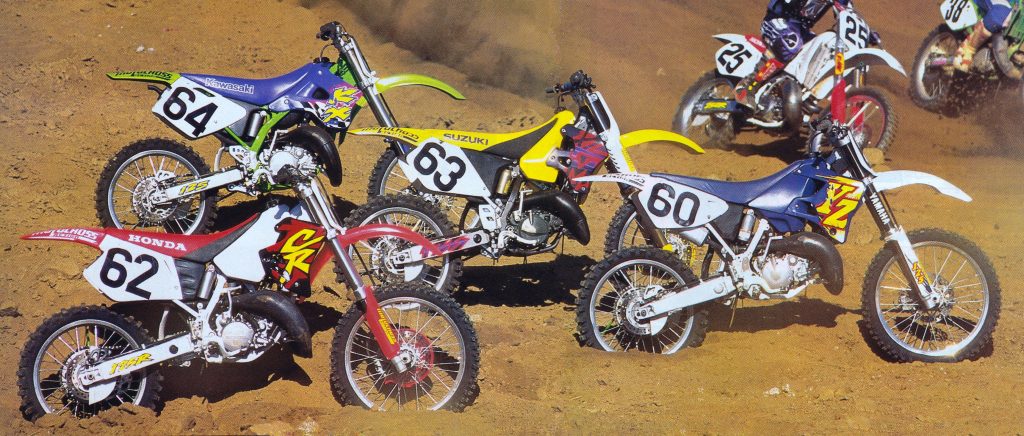 The 1996 season brought with it the most competitive lineup of 125 motocross machines ever offered by the Japanese. Photo Credit: Motocross Action
The 1996 season brought with it the most competitive lineup of 125 motocross machines ever offered by the Japanese. Photo Credit: Motocross Action
The 1990s were a great time to be racing in the 125 class. Modern technology allowed the manufacturers to extract amazing amounts of power from the tiny eighth-liter engines and major advances in suspension and chassis design meant all that performance made it directly to the track. Wide powerbands, sturdy chassis, and works-level suspension all became realities in the 125 class for the common man in the 1990s.
While the overall level of 125 performance was higher than ever in the early nineties, there continued to be a significant battle over what kind of machine made for the best 125 racer. Those devoted to the Honda camp went for high-RPM power and pin-it-to-the-stops bravado. The CRs of this era were long on revs and short on suspension finesse; a rocket motor saddled with Stone Age suspension was the CR’s calling card during these years. This was fine for fast guys who could make its stiff suspension and high-RPM power work, but it often frustrated those of lesser talent.
 By 1996, the Japanese were the only real contenders in the 125 class and none of the “Big Three” magazines chose to include KTM, Husqvarna, or TM in their standings Photo Credit: Motocross Action
By 1996, the Japanese were the only real contenders in the 125 class and none of the “Big Three” magazines chose to include KTM, Husqvarna, or TM in their standings Photo Credit: Motocross Action
In the Suzuki camp, you had riders that favored handling and power placement over maximum thrust. The RMs of the early nineties were great machines that offered razor-sharp turning and a “right-now” style of power that rocketed the RM out of corners and over obstacles with ease. What the CR accomplished with revs, the RM did with a burst, and both machines had their devotees. For Suzuki pilots, high-speed stability and shrieking top-end power were not on the menu, but for many riders the RM offered the ultimate 125 package.
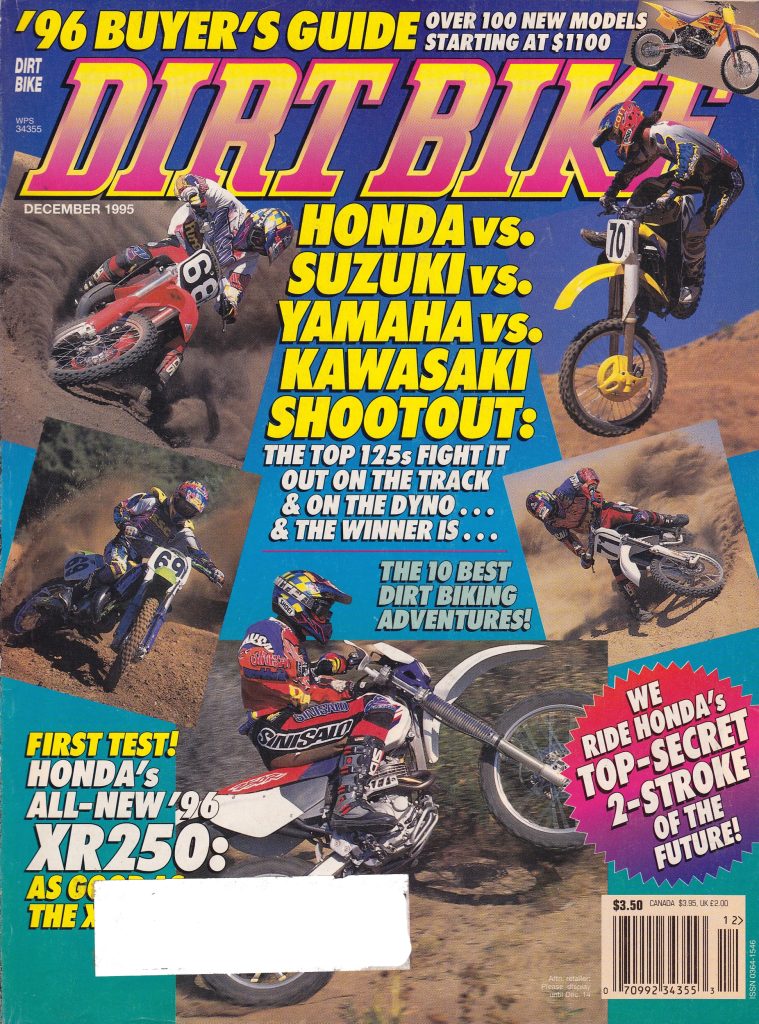 While I would love to have any of these 125s today, the bike I would really like to have in my garage is that brand new ’96 XR250R in pristine condition. Photo Credit: Dirt Bike
While I would love to have any of these 125s today, the bike I would really like to have in my garage is that brand new ’96 XR250R in pristine condition. Photo Credit: Dirt Bike
For those who placed suspension performance at the top of their “wants” list, Kawasaki was usually the machine of choice. Throughout the early part of the decade, this was the KX’s most reliable calling card. Some years it was fast and some years it was slow, but almost every year it delivered the smoothest ride in the class. With its stout perimeter frame and larger overall feel, it made a great bike for taller pilots and many riders were willing to overlook its narrow power and often problematic reliability to enjoy its magic carpet suspension.
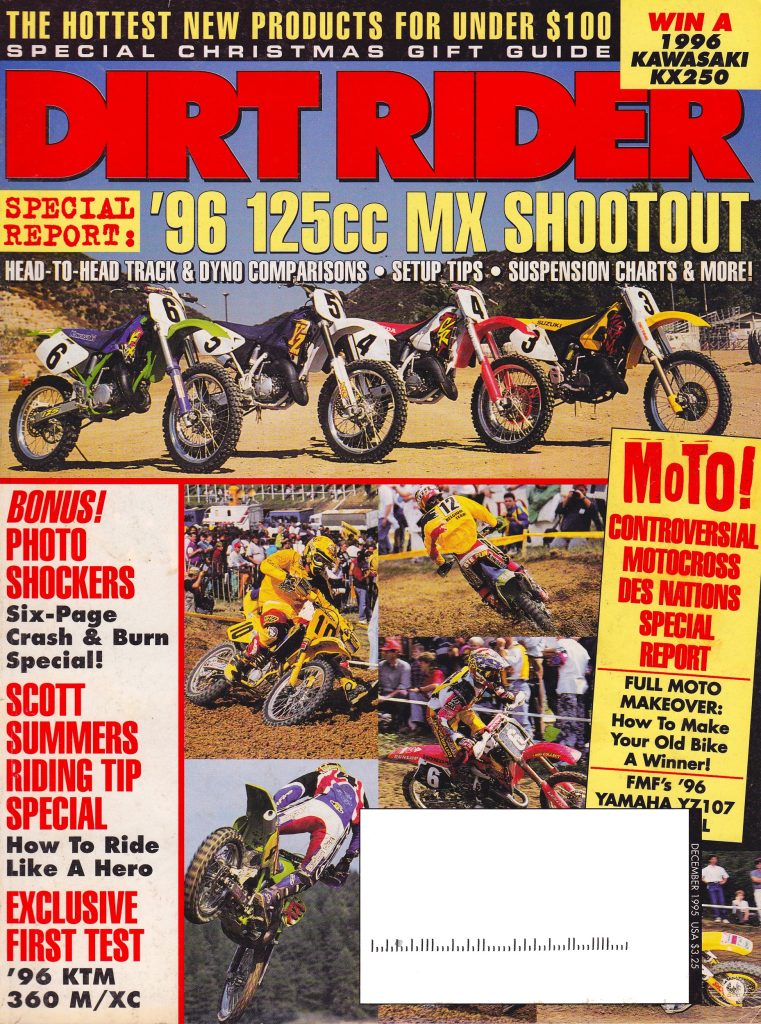 A 125 shootout and an ignominious defeat of Team USA in the 1995 Motocross des Nations highlight the December issue of Dirt Rider. In 1995, us losing this race was still a major shock after so many years of dominance by the Americans. Most people over here thought the 1994 upset by Team Great Britain was a fluke, but in 1995 Belgium showed that the Europeans were here to stay in international competition. Photo Credit: Dirt Rider
A 125 shootout and an ignominious defeat of Team USA in the 1995 Motocross des Nations highlight the December issue of Dirt Rider. In 1995, us losing this race was still a major shock after so many years of dominance by the Americans. Most people over here thought the 1994 upset by Team Great Britain was a fluke, but in 1995 Belgium showed that the Europeans were here to stay in international competition. Photo Credit: Dirt Rider
For Yamaha, the early nineties were mostly an exercise in frustration and futility in the 125 class. The YZ125s of this era suffered from narrow and flighty powerbands that were down on power and hard to use. The strong mid-range motors of the late eighties lost their burst in Yamaha’s yearly quest to broaden the YZ’s appeal. The chassis and suspension of these machines were mostly well sorted, and the bikes could be very effective with tons of motor work, but in stock condition, the YZs of the early nineties were too slow to be much of a contender.
By 1996, some of this power dynamic was finally starting to shift as newer machines started to chip away at the advantages enjoyed by long-time 125 powerhouse Honda. The motor that had ruled motocross for nearly a decade began to show its age as newer designs found ways to match its dyno numbers while also offering a broader delivery. All-new machines from Yamaha and Suzuki mimicked the Honda’s looks and feel while enjoying superior handling, better suspension, and easier-to-use power.
All told, it was the most competitive lineup of 125 machines ever offered and a tough choice for the magazines of the time. In their shootouts, not one of the three major magazines named the same overall winner, and Dirt Bike could not even decide who should get second in their comparison. Instead, they declared second place to be an overall tie between three of the competitors. While I still hate this cop-out of a decision, I can appreciate the difficulty Dirt Bike had ranking such a competitive lineup of machines.
So here, without further ado, are the 125 contenders of 1996 and how they stacked up in the magazine shootouts of the time.
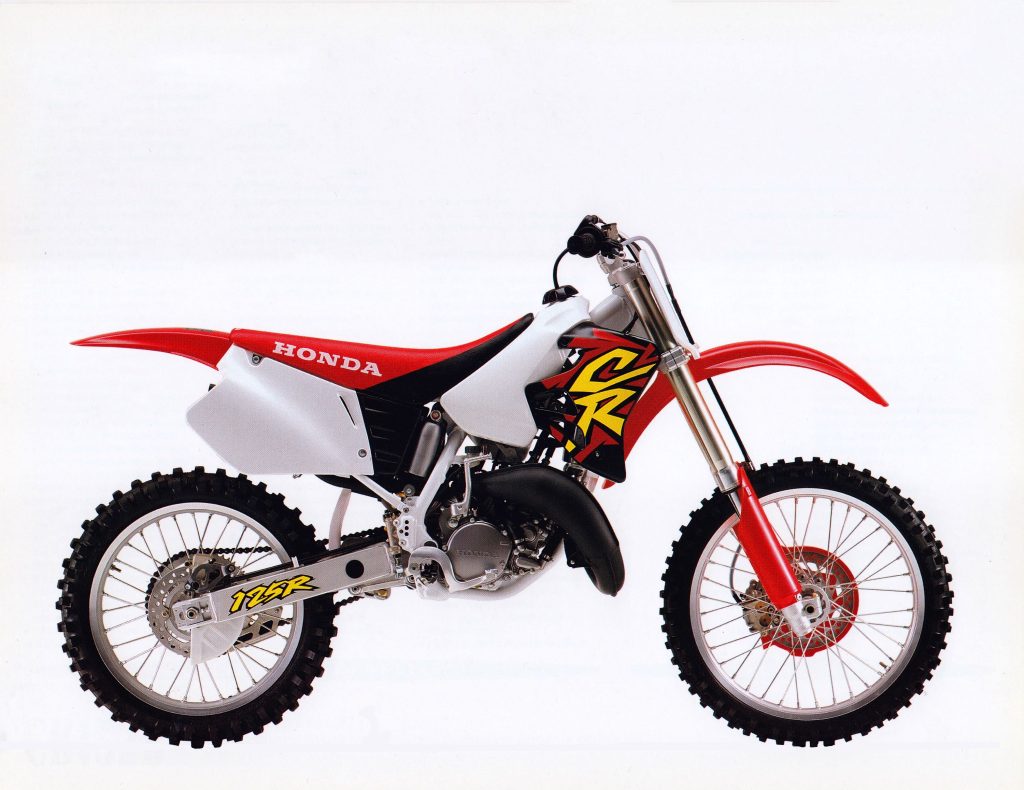 1996 Honda CR125R Shootout Rankings: Motocross Action – 3rd (out of 4) Dirt Bike – 2nd (a tie with the KX and YZ) Dirt Rider – 1st (out of 4) Photo Credit: Honda
1996 Honda CR125R Shootout Rankings: Motocross Action – 3rd (out of 4) Dirt Bike – 2nd (a tie with the KX and YZ) Dirt Rider – 1st (out of 4) Photo Credit: Honda
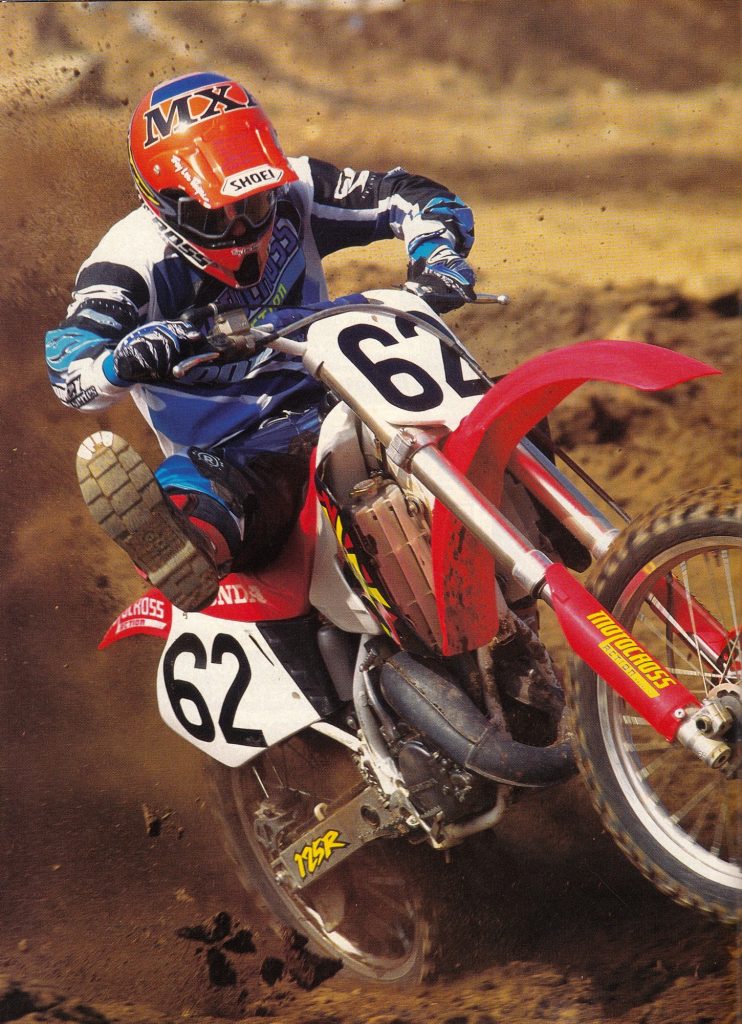 In 1996, the Honda CR125R still offered one of the most potent power packages in the class but its older chassis and lackluster suspension made it far from a unanimous choice at the top of the standings. Photo Credit: Motocross Action
In 1996, the Honda CR125R still offered one of the most potent power packages in the class but its older chassis and lackluster suspension made it far from a unanimous choice at the top of the standings. Photo Credit: Motocross Action
1996 Honda CR250R Overview: By 1996, Honda’s CR125R was starting to get a bit long in the tooth. The basic motor design dated back to 1987 with a power-valve update in 1990. While the HPP mill remained one of the fastest in the class, its all-or-nothing delivery and lack of torque made it a demanding machine to ride fast. When it was on the pipe, it was a rocket, but below its high RPM howl, there was not much to fall back on. Fast guys loved the CR’s endless pull, but those of lesser speed often found the Honda difficult to manage. If you shifted too soon or failed to carry enough momentum out of turns then the red machine bogged instead of blasting forward. This made jumps out of turns far trickier than on the more responsive RM, KX, and YZ. Gearing the CR down did help, but the Honda was never going to deliver the snappy “right now” power of its rivals.
While its powerband was demanding, the rest of the motor package was without equal. The CR’s clutch and transmission were absolutely bulletproof and the tops in the class. The RM’s pull was lighter but it could not withstand half the abuse the Honda could endure. Missed shifts, fading clutches, and exploding gearsets were not a concern for CR pilots and everyone praised the machine’s ability to make the most of its prodigious power output.
In 1996, the CR’s motor had its passionate defenders, but the bike’s chassis elicited far less enthusiasm. Once the king of the inside line, a CR’s frame went through several changes in the early nineties that left it a curious mix of mediocre turning and poor stability. The search for better high-speed manners neutered the Honda’s turning prowess and never really delivered on exorcising the machine’s often violent headshake. Body positioning and bike setup were critical to getting the Honda’s chassis to behave properly and the machine seemed far more sensitive to track conditions and chassis balance than its competitors.
Not helping matters was the Honda’s suspension which continued to offer the harshest ride in the class. Neither the forks nor shock were well regarded with their stiff and uncompliant ride. As with the motor, fast guys liked this setup the best while those of lesser talent had a hard time making it work without being beaten to death.
Overall, the 1996 Honda CR125R was a pro-focused machine with lots of potential but a lack of polish. To go fast, it demanded a lot from its pilot and punished those without the talent or determination to make the most of its high-strung nature. Harsh suspension, indifferent handling, and a road racing powerband were offset by excellent quality, flawless brakes, and the best reliability in the class. For many (including Dirt Rider), the Honda’s power, reputation, and bulletproof nature were more than enough to make it the top choice in 1996. For Motocross Action and Dirt Bike, however, the red machine’s lack of handling flair and tiring nature placed it behind newer and easier-to-manage contenders.
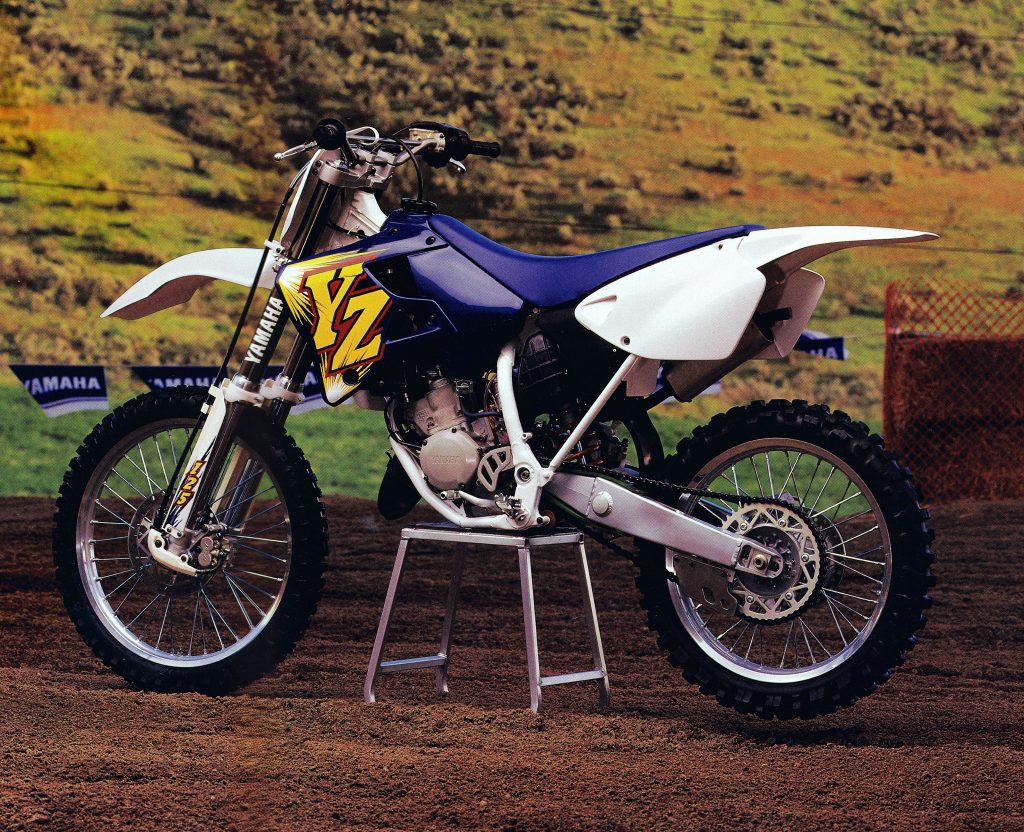 1996 Yamaha YZ125 Shootout Rankings: Motocross Action – 1st (out of 4) Dirt Bike – 2nd (a tie with the KX and CR) Dirt Rider – 3rd (out of 4) Photo Credit: Honda
1996 Yamaha YZ125 Shootout Rankings: Motocross Action – 1st (out of 4) Dirt Bike – 2nd (a tie with the KX and CR) Dirt Rider – 3rd (out of 4) Photo Credit: Honda
 All-new from the ground up, Yamaha’s 1996 YZ125 set the stage for a decade of blue dominance in the 125 class. Photo Credit: Dirt Bike
All-new from the ground up, Yamaha’s 1996 YZ125 set the stage for a decade of blue dominance in the 125 class. Photo Credit: Dirt Bike
1996 Yamaha YZ125 Overview: Throughout much of the eighties and early nineties Yamaha’s YZ125 suffered the indignity of being the doormat of the 125 class. The YZs of this era were often underpowered and infamous for their recalcitrant shifting and narrow power curves. An all-new motor in 1986 finally brought the YZ a little much-needed boost but by 1993 this engine was too slow to remain competitive in the cutthroat 125 division. In 1994, Yamaha scrapped their original YPVS design and introduced an all-new top end for their 125 racer. The new engine won the “most improved” award of 1994 but still lacked the power to outshine the competition.
After some minor refinements and another mid-pack showing in 1995, Yamaha was ready to pull out all the stops on their YZ125 for 1996. All-new from the ground up, the YZ featured a major redesign of the frame, suspension, bodywork, and styling. Even the color was new, with a switch from the white and lavender of 1995 to Yamaha’s corporate dark blue. Ironically, probably the least changed portion of the new YZ was its motor, which retained much of the 1995’s DNA in its design. To improve power, Yamaha revised the power valve’s shape and improved its sealing, changed the porting, bolted on a redesigned exhaust, added a new ignition, straightened the intake tract, and swapped out the reeds for a new lighter carbon fiber material.
On the track, these small changes added up to a dramatic shift in the YZ’s power profile. Where previous YZ125 motors had offered a strong (and sometimes not so strong) midrange and little else, the 1996 version pumped out a broad and hooked-up style of power that felt more like a small 250 than a shrieking 125. It pulled from way down low (for a 125) and could be shifted early without fear of bogging the motor and falling off the pipe. A strong midrange and decent top-end pull complemented the YZ’s torquey low end and the bike offered by far the widest power spread in the class. It did not pull as hard on top as the CR or hit as hard in the middle as the KX and RM, but it was incredibly flexible and far easier to ride than any of its rivals.
On the chassis front, the YZ was a great do-it-all machine that turned well while still offering admirable high-speed stability. It was not as sharp as the RM on tight circuits but far better than the CR and KX at holding the inside line. It never twitched or shook its head like the CR but its relatively soft stock suspension could get the YZ in over its head in really rough terrain at speed. Both the forks and shock were too soft for really fast guys and bottoming was an issue with the stock settings in place. Slower and lighter riders had less of a problem but if you were big or fast, then the stock suspension was going to need some work.
Where things went pear-shaped for the YZ was in the reliability department. Both the wheels and transmission proved very fragile and all of the major magazines suffered costly failures with their test bikes. The new radiator wings also had an annoying habit of snagging knee braces but that paled in comparison to the misery of a blown wheel or gearset. Overall, the new blue YZ proved to be the most competitive YZ125 in 16 years and the basis for over a decade of Yamaha dominance in the 125 class. It was fast, easy to ride, and handled excellently, which was more than enough to allow it to take the top spot in Motocross Action’s shootout. For Dirt Rider and Dirt Bike, the YZ’s fragility and overly soft suspension demoted it in the final standings.
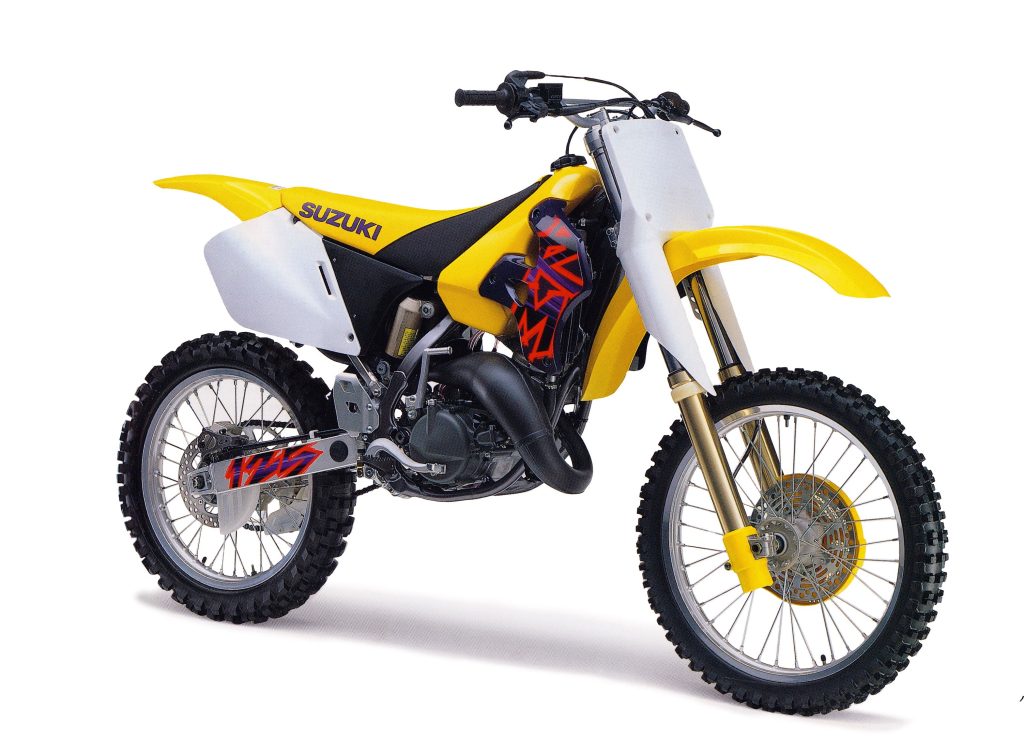 1996 Suzuki RM125 Shootout Rankings: Motocross Action – 2nd (out of 4) Dirt Bike – 1st (out of 4) Dirt Rider – 2nd (out of 4) Photo Credit: Honda
1996 Suzuki RM125 Shootout Rankings: Motocross Action – 2nd (out of 4) Dirt Bike – 1st (out of 4) Dirt Rider – 2nd (out of 4) Photo Credit: Honda
 Fantastic suspension, versatile handling, and a snappy motor made the RM one of the most popular 125s to ride in 1996. Photo Credit: Dirt Bike
Fantastic suspension, versatile handling, and a snappy motor made the RM one of the most popular 125s to ride in 1996. Photo Credit: Dirt Bike
1996 Suzuki RM125 Overview: Another all-new machine, the RM125 had a lot going for it in 1996. Styled very much like a yellow Honda, the RM offered the best overall handling in the class and radically different suspension than its rivals. Suzuki’s decision to buck conventional wisdom and return to conventional forks was controversial at the time and more than a few pit pundits were unsure as to the wisdom of the decision. While pros like Mike LaRocco and Jeremy McGrath never warmed to their performance, magazine editors and regular consumers loved their smooth action. The new 49mm conventional Showa forks combined the compliance of the old conventional designs with the rigidity and precision of the new inverted offerings to provide a ride unrivaled by its competitors. The forks were both firm enough to handle big hits and plush enough to absorb small chop. Every magazine raved about their performance and they became the single biggest advantage the RM enjoyed in 1996.
While not quite as spectacular as the forks, the RM’s shock was also praised for its excellent action. Both ends could be trusted in the rough and the RM was never caught off-guard by an unexpected bump or a misjudged landing. The handling of the new chassis was just as well-received, and the RM offered a precise feel that allowed the rider to place the bike exactly where it was intended. Where previous RMs had sacrificed stability for steering precision, the new DeCoster-designed chassis excelled at both. The RM’s excellent suspension, comfortable layout, and well-engineered geometry allowed the Suzuki to carve the inside line while also being rock-solid at speed. It was a suspension and handling package that made going fast easy and allowed the RM’s pilot to use every ounce of power the machine had to offer.
With a great chassis, comfortable layout, and the supplest suspension in the class, the RM may have seemed like a shoo-in for the top spot in 1996, but its new motor needed a few more ponies to be a unanimous victor. The revised powerplant sacrificed some of the ‘95’s strong bottom end for more midrange and this displeased some riders who loved the old RM’s “always at the ready” power. Top-end power was only average, and the RM preferred to be shifted early rather than wrung out. With its midrange focus, the motor was not as easy to ride as the year before, but the RM engine was still competitive and capable of winning. A feathery light clutch and slick shifting helped make the most of the Suzuki’s power and it was one of the most fun bikes to ride. Jumps out of turns that took tons of clutch and a locked right wrist on the Honda were conquered with ease on the ultra-quick RM. On fast outdoor circuits, the Suzuki’s lack of top-end power put it at a disadvantage to the long-legged Honda, but its excellent chassis and suspension kept it in the running.
Overall, the RM was an excellent machine in 1996. Like the Yamaha, it did suffer a few first-year teething problems that left riders with broken transmissions, but these were largely isolated incidents. For the majority of RM125 owners, the machine was an excellent racing partner. It lacked the top-end pull of the Honda and grunt of the Yamaha, but it did offer the best combination of handling and suspension in the class. For Dirt Bike magazine that was enough to snag the RM the top spot, but for Motocross Action and Dirt Rider, the RM’s narrower power limited it to second in the standings.
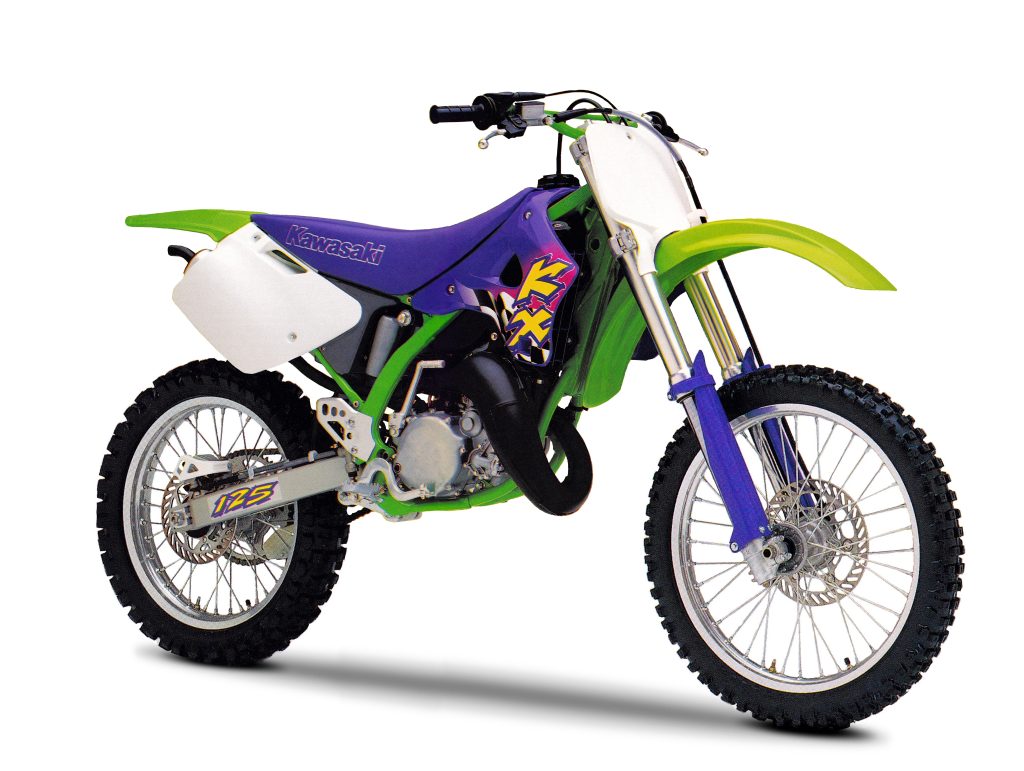 1996 Kawasaki KX125 Shootout Rankings: Motocross Action – 4th (out of 4) Dirt Bike – 2nd (a tie with the YZ and CR) Dirt Rider – 4th (out of 4) Photo Credit: Honda
1996 Kawasaki KX125 Shootout Rankings: Motocross Action – 4th (out of 4) Dirt Bike – 2nd (a tie with the YZ and CR) Dirt Rider – 4th (out of 4) Photo Credit: Honda
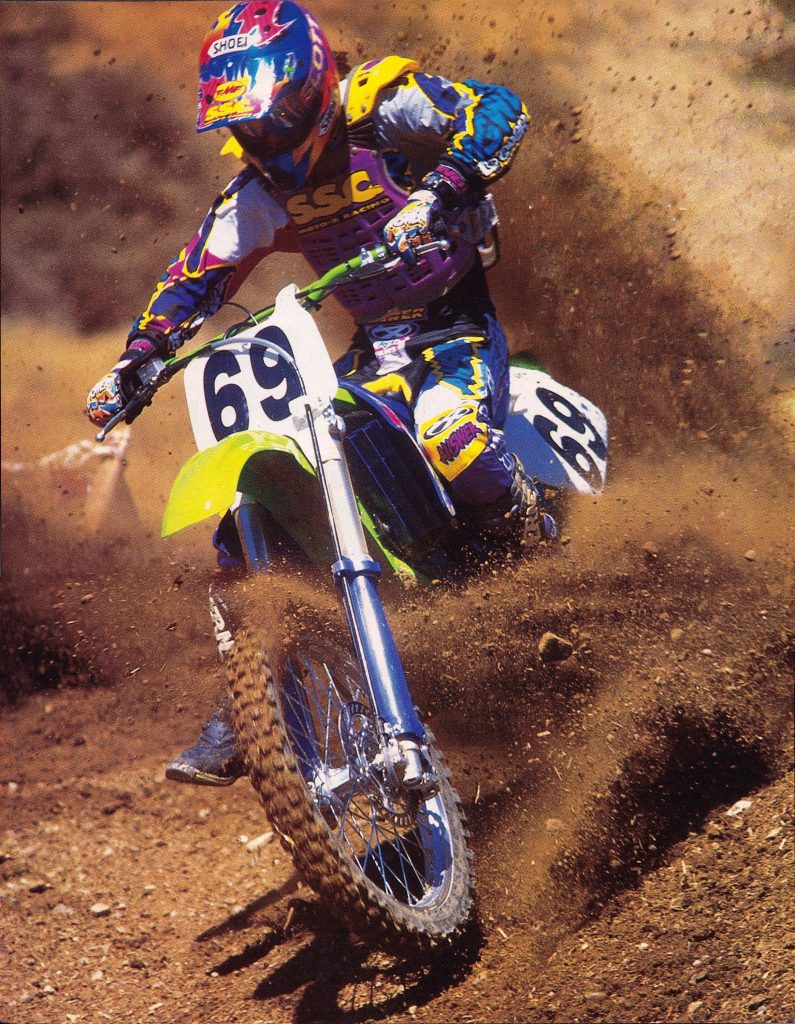 In 1996, the KX125 offered bold styling, a hard-hitting motor, and a larger feel than its rivals.
In 1996, the KX125 offered bold styling, a hard-hitting motor, and a larger feel than its rivals.
1996 Kawasaki KX125 Overview: In the third year of its design cycle, the 1996 KX125 was more about refinement than reinvention. All-new in 1994, the third generation of Kawasaki’s perimeter frame offered a roomy layout and solid feel that taller and larger 125 pilots appreciated. Never as quick in the turns as its 125 rivals, the KX’s big feel made the bike seem heavier and less nimble than its competitors despite handling that often rivaled them in performance. In 1996, Kawasaki changed the porting and modified the KIPS to boost mid-to-top performance as well as increased overall compression. They also beefed up the suspension with an all-new 46mm (3mm larger than 1995) fork and revised ratios for the Uni-Trak rear suspension.
On the track, these changes added up to a machine that lacked the all-round competence of its rivals. The new motor snapped to attention off idle and pulled with authority into the midrange before demanding another shift. Top-end power was completely nonexistent and the KX required a lot of shifting to keep it from falling out of the meat of its power. When it was on the pipe, it was fast but that burst was fast-moving and hard to harness. The transmission was also more stubborn than the Honda and Suzuki and that added to the difficulty in keeping the green (purple) machine at the front. Like the Honda, the Kawasaki required a skilled hand to make the most of its power and this limited its appeal compared to the easier-to-ride motors of the Yamaha and Suzuki.
As with the motor, the KX’s suspension was just a bit off the mark in 1996. The new front forks worked decently well but were too soft when paired with the stiff rear end of the KX. This gave the bike an unbalanced feel that hindered its handling. Once the suspension was leveled out the KX was a good handler, but it remained better suited to larger and more aggressive riders. Many KXs also suffered from motor problems derived from improper finishing of the cylinder at the factory. Taking the top end apart and having it cleaned up was a must if you did not want to suffer a costly failure. Race gas was also a good idea as the KX liked to grenade if ridden hard on pump gas.
Overall, the 1996 KX125 was a bike with a lot of potential in need of some additional finishing at the factory. With a little motor work and suspension fine-tuning the KX could certainly win even at the highest levels, but in stock condition, it remained an unrefined package that ranked at the back of the 125 pack in 1996.



